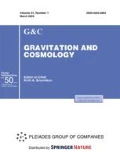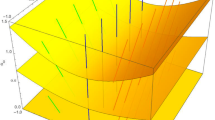Abstract
—The paper is devoted to some of the difficulties which the Wheeler-DeWitt quantum geometrodynamics encountered, in particular, a strong mathematical proof that this theory is gauge-invariant, the definition of the wave function of the Universe through a path integral and the illegality of asymptotic boundary conditions in quantum gravity, the derivation of the Wheeler-DeWitt equation from the path integral and the equivalence of the Dirac quantization scheme with other approaches, the problem of definition of physical states in quantum gravity, possible realizations of the Everett concept of “relative states.” These problems are rarely discussed in the literature. They are related to the guiding idea that quantum theory of gravity must be gauge-invariant. It will lead to the question if it is possible to achieve this goal in a mathematically consistent way.
Similar content being viewed by others
References
B. S. DeWitt, “Quantum theory of gravity. I. The canonical theory,” Phys. Rev. 160, 1113 (1967).
P. W. Higgs, “Integration of secondary constraints in quantized general relativity,” Phys. Rev. Lett. 1, 373 (1958).
C. Kiefer, Quantum Gravity (Oxford University Press, Oxford, 2007).
J. B. Hartle, “Quantum cosmology: Problems for the 21st Century,” in Proceedings of the 11th Nishinomiya-Yukawa Symposium, Ed. K. Kikkawa, H. Kunitomo, and H. Ohtsubo (World Scientific, Singapore, 1998).
C. Kiefer, “Conceptual issues in quantum cosmology,” in Towards Quantum Gravity. Proceeding of the XXXV International Winter School on Theoretical Physics Held in Polanica, Poland, 2–11 February 1999, Ed. by J. Kowalski-Glikman (Lecture Notes in Physics, v. 541, Springer, Berlin, 2000).
C. Rovelli, Quantum Gravity (Cambridge University Press, Cambridge, 2007).
C. Rovelli, “The strange equation of quantum gravity,” Class. Quantum Grav. 32, 124005 (2015).
P. A.M. Dirac, “Generalized Hamiltonian dynamics,” Can. J. Math. 2, 129 (1950).
P. A.M. Dirac, “Generalized Hamiltonian dynamics,” Proc. Roy. Soc. A 246, 326 (1958).
S. W. Hawking and D. N. Page, “Operator ordering and the flatness of the Universe,” Nucl. Phys. B 264, 185 (1986).
A. O. Barvinsky, “Operator ordering in theories subject to constraints of the gravitational type,” Class. Quantum Grav. 10, 1985 (1993).
J. B. Hartle and S.W. Hawking, “Wave function of the Universe,” Phys. Rev. D 28, 2960 (1983).
S. W. Hawking, “The path-integral approach to quantum gravity,” in General Relativity. An Einstein Centenary Survey, Ed. by S.W. Hawking and W. Israel (Cambridge University Press, Cambridge, 1979).
L. D. Faddeev and V. N. Popov, “Feynman diagrams for the Yang-Mills field,” Phys. Lett. B 25, 29 (1967).
L. D. Faddeev, “The Feynman integral for singular Lagrangians,” Theor. Math. Phys. 1, 1 (1969).
E. S. Fradkin and G. A. Vilkovisky, “Quantization of relativistic systems with constraints,” Phys. Lett. B 55, 224 (1975).
I. A. Batalin and G. A. Vilkovisky, “Relativistic Smatrix of dynamical systems with boson and fermion constraints,” Phys. Lett. B 69, 309 (1977).
E. S. Fradkin and T. E. Fradkina, “Quantization of relativistic systems with boson and fermion firstand second-class constraints,” Phys. Lett. B 72, 343 (1978).
I. A. Batalin and G. A. Vilkovisky, “Gauge algebra and quantization,” Phys. Lett. B 102, 27 (1981).
A. O. Barvinskiy and V. N. Ponomariov, “Canonical quantization of gravity and quantum geometrodynamics,” Izv. Vuzov, Fizika 3, 37 (1986).
A. O. Barvinskiy and V. N. Ponomariov, “Quantum geometrodynamics: the path integral and the initial value problem for the wave function of the Universe,” Phys. Lett. B 167, 289 (1986).
J. J. Halliwell, “Derivation of the Wheeler–DeWitt equation from a path integral for minisuperspace models,” Phys. Rev. D 38, 2468 (1988).
V. A. Savchenko, T. P. Shestakova, and G. M. Vereshkov, “Quantum geometrodynamics of the Bianchi IX model in extended phase space,” Int. J. Mod. Phys. A 14, 4473 (1999).
V. A. Savchenko, T. P. Shestakova, and G. M. Vereshkov, “The exact cosmological solution to the dynamical equations for the Bianchi IX model,” Int. J. Mod. Phys. A 15, 3207 (2000).
V. A. Savchenko, T. P. Shestakova, and G. M. Vereshkov, “Quantum geometrodynamics in extended phase space—I. Physical problems of interpretation and mathematical problems of gauge invariance,” Grav. Cosmol. 7, 18 (2001).
V. A. Savchenko, T. P. Shestakova, and G. M. Vereshkov, “Quantum geometrodynamics in extended phase space—II. The Bianchi IX model,” Grav. Cosmol. 7, 102 (2001).
M. Hennaux, “Hamiltonian form of the path integral for theories with a gauge freedom,” Phys. Rep. 126, 1 (1985).
T. P. Shestakova, “The role of BRST charge as a generator of gauge transformations in quantization of gauge theories and gravity,” Tomsk State Pedagogical University Bulletin 153, 224 (2014).
T. P. Shestakova and C. Simeone, “The problem of time and gauge invariance in the quantization of cosmological models. I. Canonical quantization methods,” Grav. Cosmol. 10, 161 (2004).
T. P. Shestakova and C. Simeone, “The problem of time and gauge invariance in the quantization of cosmologicalmodels. II. Recent developments in the path integral approach,” Grav. Cosmol. 10, 257 (2004).
L. D. Landau and E.M. Lifshitz, The Clssical Theory of Fields (Oxford, 1975).
H. Everett, “‘Relative state’ formulation of quantum mechanics,” Rev. Mod. Phys. 29, 454 (1957).
T. P. Shestakova, “Is the Wheeler-DeWitt equation more fundamental than the Schro¨ dinger equation?” Int. J. Mod. Phys. D 27, 1841004 (2018).
S. W. Hawking, “Particle creation by black holes,” Commun. Math. Phys. 43, 199 (1975).
Author information
Authors and Affiliations
Corresponding author
Additional information
The present issue of the journal is No. 100 since it was founded in 1995.
Rights and permissions
About this article
Cite this article
Shestakova, T.P. Wave Function of the Universe, Path Integrals and Gauge Invariance. Gravit. Cosmol. 25, 289–296 (2019). https://doi.org/10.1134/S0202289319040121
Received:
Revised:
Accepted:
Published:
Issue Date:
DOI: https://doi.org/10.1134/S0202289319040121



